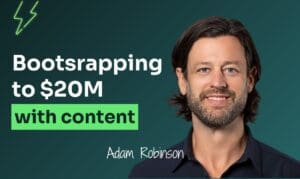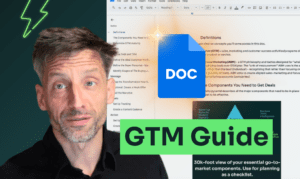Flipping the perspective on thought leadership
The goal of thought leadership simply put is: make your company look smart, so as to build authority. While true, it’s the wrong perspective.
We’re fans of framing goals and strategy from the viewpoint of the customer. Our advice: flip this around and approach “thought leadership” from the buyer’s perspective. More specifically, on the value they get. Make that the goal: provide help, advice, value, entertainment, encouragement, positivity, connection.
It’s not about you looking smart.
Remember episode seven? It’s about serving and showing up. You will end up looking smart and building authority, but don’t approach it that way. Frank Kern often jokes: the oldest trick in the book is to help people… by actually helping them.
Who should be the thought leader – people or the brand?
The majority of your providing value will happen on LinkedIn. LinkedIn has a bias towards people and against company pages. You’ll get much better reach and interaction if your buyer-facing people (leadership team and sales/biz dev, customer success) show up.
Your company page can share their posts, but count on having the interaction and conversations on your peoples’ posts.
The best content-type for building authority
The best content type is the one you can produce the easiest. For me it’s video, for many others it’s writing. Video has the super-advantage that it’s easy to repurpose into many other content forms: podcasts, blogposts, micro-content for social media and even longer form written content. On LinkedIn, video posts generally get higher reach and more engagement.
OK, but what should you be talking about? This question hinders many people from starting to build authority serve the market, but with the right mindset it’s an easy one.
An endless supply of the perfect content
What you do, think about and learn on a daily basis has so many implications for your target audience. Once you get in the habit of thinking about content to share, ideas will start flowing naturally.
- Taking lessons from a book or article you’re reading
- Talking about a win at the company — with an educational angle.
- Sharing the solution to a problem you’ve solved
- Sharing an educational or inspiring conversation you’ve had
The main idea is that a lot of what inspires you or gives you an ‘aha’ moment will be relevant for your audience. The key is to really know your audience, meaning the ideal customer (in terms of company-profile) as well as key buyer personas. And demonstrate value to them specifically.
A few pointers to keep in mind when developing content… especially if you want to stand out in a world filled with dull B2B
- Always have an outcome in mind for your audience. What is the one thing your content will help with?
- Don’t just be informative. Make it personal, share an experience.
- Be inspiring, share your passion.
Common obstacles… and mistakes in thought leadership
One of the first bumps in the road for tech service and development companies is: but we have so many “ideal” customers… serve so many verticals and can build just about anything.
Unless you have a defined target market and buyer persona, you can only talk about general things. You’ll remain a generalist and you’ll never get the prestige and financial benefits of a specialist. It’ll be much harder to strike a chord with prospects
Related Posts
- SDR superpowers for account-based marketing - ep 8
Be'Anka Ashaolu, VP of Marketing at Propel and Dan from Klear dive-into some exciting parts…
- Your prospects don't care about you - ep 7
Fundamentally, all your prospects care about is what you can do for them. Not the…
- The simple B2B growth-marketing play - ep 3
Can you have success with almost zero marketing? Some believe it’s possible. Up to a…

